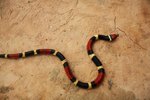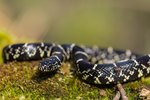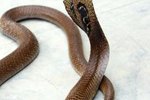
The family Viperidae contains many of the world's venomous snakes, but not all of them. The genera and species within the family are highly diverse, with some species living near water, in trees, deserts, dense forests or grasslands. Most are nocturnal ambush predators that rely on the quickness of their deadly strike to subdue their unsuspecting prey.
Viperidae
These snakes are characterized by hollow, hinged fangs that fold against the roof of their mouth when the mouth is closed. Upon striking, the fangs swing outward to be able to pierce the skin of their prey. Most of these snakes possess large, triangular heads with jaws that can open nearly 180 degrees when striking. These venomous snakes are found on every continent except Australia and Antarctica.
North American
North American pit vipers include rattlesnakes, copperheads and cottonmouths. Several of the species included in these three groups inhabit warmer areas, such as the subtropical regions of the South or the arid regions of the Southwest. Others, such as the timber rattlesnake and massasauga, inhabit cooler areas like the Midwest and Great Plains. Rattlesnakes are distinguished from other species by the presence of flattened segments on their tails that make a distinctive rattling noise. Copperheads have unmarked heads that typically show the characteristic copper color. Cottonmouths are so named because the insides of their mouths are a cottony white, a trait they show off before striking.
African
Africa contains several different genera and species of vipers, including the Gaboon viper, also called the Gaboon adder, desert horned viper and green bush viper. According to University of Michigan's Animal Diversity Web, the Gaboon viper is the longest of the vipers with an average length of just under 4 feet. They have been found, however, to exceed 7 feet. African vipers inhabit a wide range of natural habitats including grasslands, dense forests and rainforests, and deserts.
Other Vipers
The northern viper, also called the adder, has one of the largest ranges of any venomous snake. These medium-sized snakes range from as far north as the Arctic Circle and down to the Mediterranean Sea, according to the University of Michigan Animal Diversity Web. The green jararaca is most commonly found in Amazonian regions or forests around the equator in various South American countries.
References
- National Audubon Society Field Guide to Reptiles and Amphibians; John L. Behler and F. Wayne King
- Animal Diversity Web: Bitis Gabonica
- Animal Diversity Web: Desert Horned Viper
- Animal Diversity Web: African Bush Viper
- BBC: Nature Wildlife -- Vipers
- Idaho Museum of Natural History: Family Viperidae
- Animal Diversity Web: Vipera Berus
- Animal Diversity Web: Bothriopsis Bilineata
Resources
Photo Credits
-
Jupiterimages/Photos.com/Getty Images
Writer Bio
With a professional background in gardening, landscapes, pests and natural ecosystems, Jasey Kelly has been sharing her knowledge through writing since 2009 and has served as an expert writer in these fields. Kelly's background also includes childcare, and animal rescue and care.




